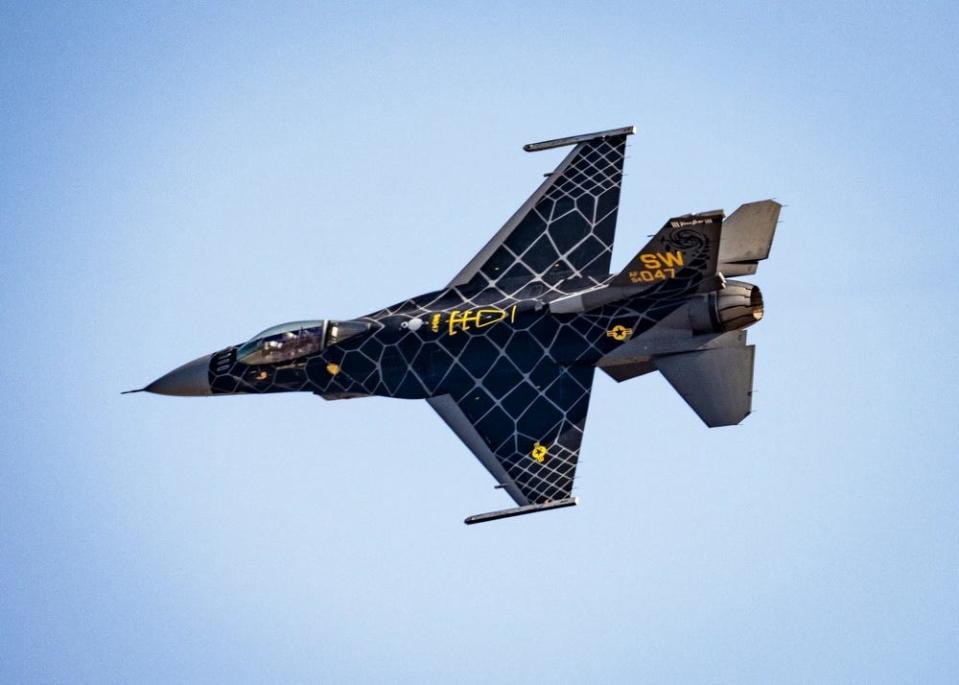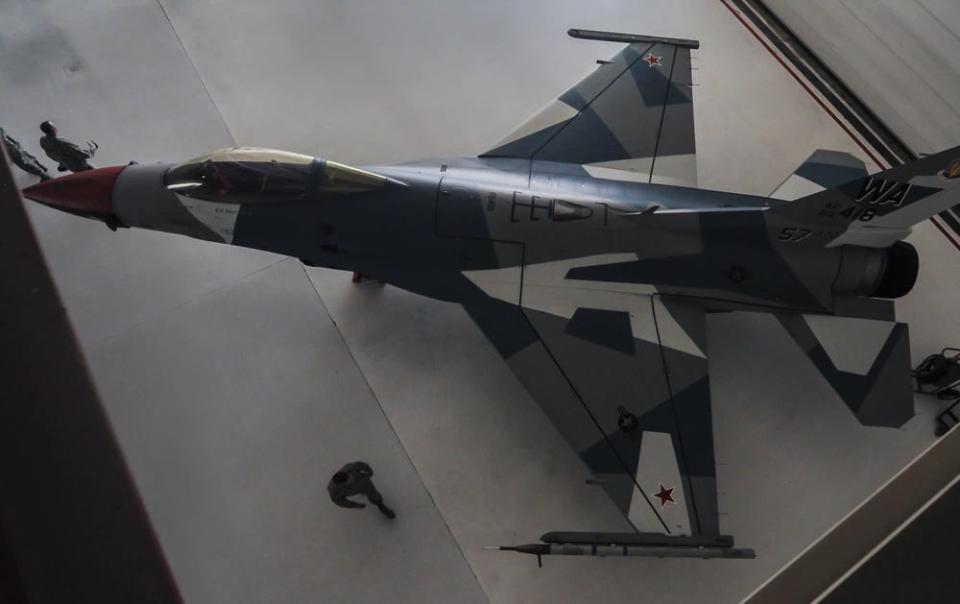The F-16 hit 50 years of flying. These photos show the Viper in action.
The F-16 Fighting Falcon celebrated the 50th anniversary of its maiden flight on January 20.
The F-16 first graced the skies in 1974 at Edwards Air Force Base in California.
The F-16 is still used in combat today, and is expected to be transferred to Ukraine this year.
The F-16 Fighting Falcon marked 50 years since its first flight on January 20, 1974.
Built by General Dynamics and now Lockheed Martin for the US Air Force, the Fighting Falcon, better known as the Viper to those who fly and maintain it, is a compact, multi-role fighter jet used in air-to-air and air-to-surface combat.
More than 4,500 aircraft for more than two dozen nations have been produced since 1974. It's flown in countless military missions by the US and its allies. Ukrainian pilots began training on actual F-16s late last year.
A near-disastrous first flight

Though the YF-16 had its first official flight on February 2, 1974, the anniversary of its unofficial first flight less than two weeks earlier marked an unusual first chapter for the iconic jet.
Phil Oestricher, the test pilot on the flight, intended to fly about 1,000 feet down the runway during the fast taxi test. But he avoided near disaster after a wiring issue caused the airplane's exhaust nozzle not to open up.
"I started the run — and the airplane accelerated very smartly, of course — pulled the power back, and we had an unfortunate wiring problem when the airplane exhaust nozzle would not open up, thus killing thrust," Oestricher said during an interview in 2012. "The airplane was very sensitive and rolled violently left; I countered with an equally violent right."
What ensued was a pilot-induced oscillation, in which a pilot inadvertently conducts a series of corrections in an effort to control the aircraft.
"The airplane pulled back and forth really quickly," Oestricher said. "It's turning left all this time. I could see it was going to go out in the dirt, so I just powered up and let go of the controls and let it fly away."
The plane banked hard left, traveling downwind, coming around, and landing shortly after. Oestricher said he was "barely touching the stick, if at all." The short-lived flight still rendered an "incredible amount of data" about the airplane, he said.
"Having been involved in the program in the very beginning, it gives me a great sense of pride and being very thankful for having been a member of the team that produced this remarkable milestone in combat aircraft, especially by today's standards," Oestricher said.
Supersonic speeds

Since its near-disastrous first flight, the Viper has logged about 19.5 million flight hours over numerous military campaigns and exercises.
The supersonic jet clocks speeds of up to 1,500 miles per hour — twice the speed of sound.
Spitting fire

The F-16 features an afterburner that produces a second stage of thrust, which appears like it's spitting fire from the rear of the aircraft. The afterburner is used in takeoff, combat maneuvers, and supersonic flight and consumes fuel at a rapid rate.
Complex aerobatics

The Viper is an all-weather, highly maneuverable aircraft, giving it the ability to evade enemy fire while its guided missiles accurately hit targets.
"Its smooth blended-wing body provided extra lift and control; its critical fly-by-wire system kept the design stable and increased its agility; and its slightly tilted back ejection seat, side-mounted control stick, head-up display, and bubble canopy improved pilot survivability as well as visibility and control," the company says on its website.
The Viper, however, lacks the stealthy features that may be needed against adversaries armed with sophisticated air defense networks that can shoot down spotted aircraft. This is part of the reason that aviation experts believe the F-16 by itself won't shift the momentum in Ukraine's favor when it arrives.
'Fire and forget' weapons

The F-16 can carry armaments needed for aerial combat or ground attack.
The Viper's payload can include up to six air-to-air missiles, conventional air-to-air and air-to-surface munitions, and electronic countermeasure pods. It also carries Joint Direct Attack Munitions (JDAM), a bomb outfitted with a guidance system that can hit targets up to 45 miles away.
The missile's guidance systems guide it to its target, allowing the pilot to perform flight maneuvers to evade enemy fire.
It's also armed with a 20mm multibarrel cannon.
Leveling the aerial battlefield in Ukraine

Late last year, Ukrainian pilots shifted from flight simulators to training on actual F-16 fighter jets. Ukraine has long sought to add the Western fighter jet to its diminished fighter fleet in hopes it will secure an edge in the war with Russia.
Though the F-16 isn't the newest jet the US has, it's still a valuable and versatile asset in Ukraine's arsenal and will help defend Ukraine's airspace and more effectively fire US-designed missiles.
Unique paint jobs

When it's not sporting an understated color scheme in combat, the Viper is known for its unique paint jobs, like the one above resembling snakeskin.
The Orange Lion

The animal-inspired paint schemes continue with an F-16 flown by the Royal Netherlands Airforce demo team sporting a fearsome lion across its wingspan.
Mako shark

The F-16 took a page from the A-10 Thunderbolt's book, emulating its shark teeth warpaint design. The F-16 features the likeness of a Mako shark from its engine inlet to its tail.
World Series Champions

When the Washington Nationals won the World Series in 2019, the F-16 also partook in celebrations, parading the team's logo on its tail.
Completely gold

Sometimes, elaborate designs aren't needed to make the F-16 stand out. This F-16 in Sioux City, Iowa, was painted solid gold to mark the Air Force's 75th anniversary in 2022.
'Splinter' camouflage

One F-16 featured a "splinter" scheme in its paint job, seemingly inspired by the pattern of Russia's fighter-bomber, the Sukhoi Su-34S, a twin-engine supersonic jet whose capabilities have been compared to the Viper.
Ghost jet

A social media poll rendered this unique "Ghost" paint scheme on an F-16 at Nellis Air Force Base in Nevada. After a month of masking, sanding, washing, priming, and painting, the Ghost jet made its first flight in May 2019.
"I love this job, and I love what we do at Nellis Air Force Base, so I want to take any opportunity to boast about our fine men and women who do great work for their nation," Brig. Gen. Robert Novotny, 57th Wing commander, said at the time. "Social media gives me a chance to connect directly with the folks who have a similar passion for military aviation."
Read the original article on Business Insider


